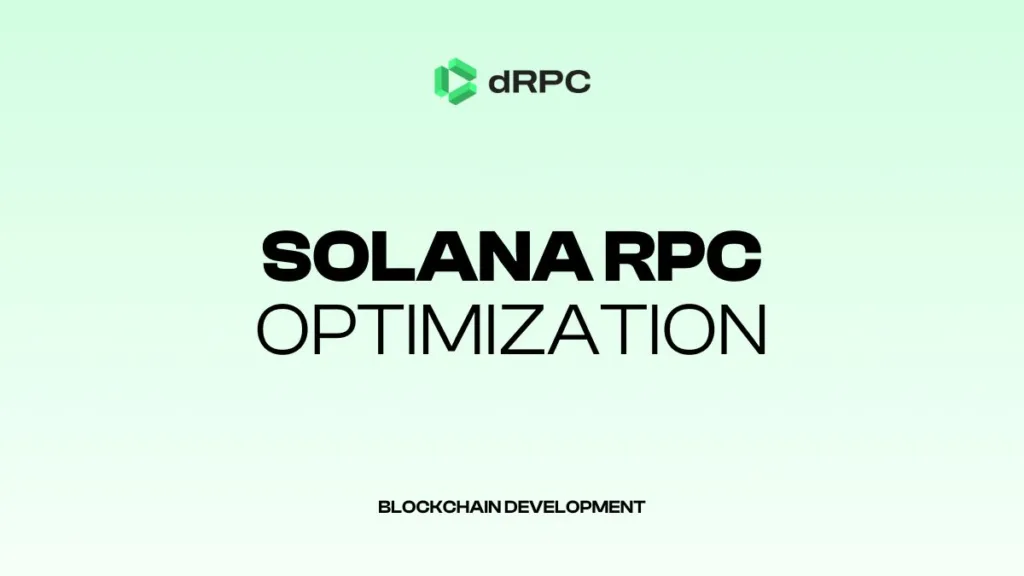Optimize your Solana RPC calls to boost dApp performance and reduce costs. This guide covers essential techniques for efficient Solana API usage that directly impact your application’s performance.
Implementation Overview
| Technique | Function | Impact | Implementation Difficulty |
|---|---|---|---|
| Filtering | Limits data returned by targeting specific criteria | Reduces response size, lowers bandwidth usage | Low |
| Pagination | Breaks large datasets into manageable chunks | Improves load times, reduces API load | Medium |
| Caching | Stores frequently accessed data locally | Eliminates redundant network requests | Medium |
| WebSockets | Enables real-time updates without polling | Reduces server load, provides instant data | Medium-High |
| Circuit Breakers | Prevents cascading failures during outages | Improves system resilience | Medium |
Efficient RPC Calls
Implementing filters in RPC calls delivers targeted data retrieval. Using getProgramAccountsFilter narrows down search criteria based on byte size, location in serialized account data, or specific values. This excludes unnecessary data, reducing response size and improving performance.
Pagination breaks large data sets into manageable chunks. When retrieving account transactions, pagination divides results into pages with a fixed number of entries per page. This optimizes load times, decreases data volume per call, and enhances performance for extensive datasets.
Caching frequently accessed API data locally creates a performance multiplier. Subsequent requests for identical information serve from the cache without new API calls. This reduces network requests, speeds up response times, and decreases load on RPC infrastructure — particularly valuable for displaying frequently accessed data like user NFTs.
Maximizing Performance
Optimize Solana RPC requests by:
- Selecting the correct method for each specific task
- Using filters to limit returned data
- Bundling transaction instructions for efficiency
- Implementing Single Flight RPC and caching
- Adding circuit breakers and rate limits to improve reliability
Monitoring Usage
The dRPC dashboard provides comprehensive monitoring capabilities:
- Rate limiting to prevent server overloads
- Notification systems for proactive monitoring
- Balance tracking and notifications
- Compute Unit (CU) level monitoring with:
- Current CU level tracking
- Average daily usage metrics
- Warning and critical level alerts
Optimizing Solana RPC Requests
Using WebSockets for Real-Time Updates
WebSockets create efficient bidirectional communication channels that outperform traditional RPC requests. Subscriptions allow applications to listen for specific events, eliminating continuous server polling. This event-driven approach ensures data transmits only when needed, reducing unnecessary requests and improving performance.
WebSockets simplify real-time data handling while maintaining application reliability through proper API response management and circuit breakers that prevent system overload during high usage periods.
Implementing Filters for Targeted Data Retrieval
Use parameters like fromBlock, toBlock, and address to limit returned data. When using getProgramAccounts, employ GetProgramAccountsFilter to filter accounts based on byte sizes or specific values. This reduces network traffic and eliminates client-side filtering.
Implementing Pagination for Large Data Sets
Pagination limits data returned in one response, making it easier to manage and decreasing response time. When retrieving NFTs, use parameters like page and perPage to fetch data in smaller chunks. Combined with filters, this approach minimizes data transferred per request, significantly improving performance for data-intensive applications.
Advanced Techniques
Caching Responses for Faster Access
Store frequently-used API data in memory to eliminate repeated API calls. This reduces:
- Network latency
- API request costs
- Server load
- Response times
Implement cache invalidation strategies to ensure data freshness while maintaining performance benefits.
Implementing Circuit Breakers for Error Handling
Circuit breakers monitor failed requests and set thresholds to pause requests during issues. This prevents reliability problems by stopping unnecessary API calls during system stress. Incorporate circuit breakers to ensure smooth error handling and maintain system performance.
Managing Rate Limits for Efficient Usage
Set rate limits based on your dApp’s requirements. Track requests, verify against limits, and implement request queuing to prevent exceeding thresholds. To optimize within rate limits:
- Use filters to reduce data volume
- Implement Single Flight RPC for streamlined calls
- Use pagination for large datasets
- Monitor usage with dRPC’s dashboard tools
Troubleshooting
Handling Response Codes and Error Messages
Monitor response codes to verify RPC request success. Handle errors gracefully to prevent retry loops that trigger rate limiting. Implement circuit breakers to avoid excessive network requests during outages.
Compression Techniques to Improve Transmission Speed
Apply algorithms like Gzip to compress RPC call data, reducing transmission time and bandwidth usage. This improves response speeds, reduces network congestion, and lowers data transfer costs.
Best Practices Summary
- Use WebSockets for real-time updates
- Implement targeted data filtering
- Apply pagination for large datasets
- Cache frequently accessed data
- Add circuit breakers for system resilience
- Set appropriate rate limits
- Monitor performance metrics
- Use compression for improved transmission
FAQ
What is Solana RPC optimization? Configurations and techniques that improve network performance through endpoint settings adjustments, including max connections and request rate limits.
Why is Solana RPC optimization important? It reduces latency, improves transaction processing speed, and enhances dApp user experience.
How can I measure optimization performance? Track response times, error rates, and network throughput using Solana metrics dashboard or the dRPC monitoring tools.
What tools help with Solana RPC optimization? dRPC dashboard, Solana’s perf-utils, and solana-bench-tps help identify bottlenecks and optimize performance.


